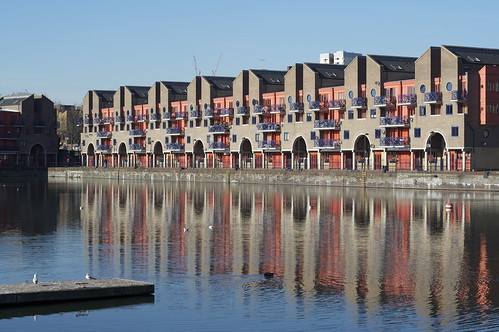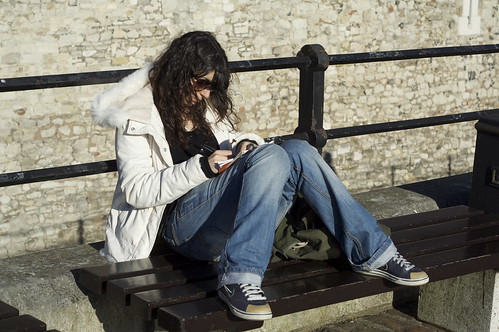I picked up the Thames path where I left off, in Greenwich, and crossed straight under the river to the Isle of Dogs. The Greenwich foot tunnel itself is kind of freaky; I’m not normally susceptible to claustrophobia, but I got a definite twinge here. I took the stairs down, which made me conscious of how deep underground it was; and then the tunnel is quite narrow, and feels surprisingly long. And if you start thinking too much about the mass of the Thames sitting above you…
Anyway, the Idle of Dogs [sorry, that’s a typo, but it would make a good title for something, don’t you think?]. I mentioned that during the last section there were occasional outcrops of upmarket apartment blocks among the industrial landscape. As far as you can tell from the Thames path, on the Isle of Dogs that process is now complete. The riverfront is almost completely residential for this section of the walk. And the exceptions are offices rather than industry. It’s a dramatic change, since this was once one of the greatest trading centres in the world. The docks are still there, huge stretches of water now serving as watersport centres, or marinas, or just gigantic decorative water features; and many of the wharves and factories have been adapted into apartments and offices. But it’s remarkable how little these physical traces of the past give any sense of what it must have been like. In the absence of noise and smell and dirt, with no real traffic on the river, the old hoists that have been left on the sides of converted warehouses just seem like some peculiar local architectural vernacular: steampunk genteel.

The buildings I found most attractive were those which seemed to have an intimacy with the river. That usually meant converted wharves. Not just because they’d had the chance to weather and age into the landscape, but because they’d been built right up on the river, overhanging the water. The new-built apartment blocks are quite different. In some ways, the river is the reason for their existence; they were built where they were because the developers know people will pay good money for a river view. But it’s a view. The river is something they look over and look across. It could be anything; as it happens, it’s a river. The apartment blocks don’t even have a relationship with each other; the Thames Path regularly has to leave the river to skirt around buildings not because they are physically blocking the way, but because they have big walls and fences covered in private property signs. I understand the desire for security, but there’s something faintly depressing about a whole row of apartment blocks all treating each other as the enemy.
Just occasionally you find a corner that gives you an idea of what this part of London could have been like: a city on the water, a kind of Venice with docks replacing the canals. Perhaps Venice is a bit optimistic, but the redevelopment of a whole area of London has to be an opportunity to do something remarkable; on the whole that opportunity has been wasted. Not that the area is a disaster; hell, I wouldn’t mind one of those apartments with a view of the river for myself. But it’s not a triumph, either.

The most striking collision of architecture and the water is Canary Wharf, where from the right angles, the skyscrapers seem to rise out of sheets of water. Which is spectacular, in a 60s-vision-of-the-future sort of way. I remember when it was just the Canary Wharf Tower standing alone, then the tallest building in Europe, towering over the area. It had only just been completed when the property market collapsed, and it stood half-empty for a long time. You used to be able to see it from all over south London. In the post-binge guilt of the early 90s, it seemed like a visible symbol of the greed and hubris of the 80s. Now, with Canary Wharf a major centre for London’s financial industry, and a whole rash of big new tower blocks planned for London, that original building seems ahead of its time; visionary, almost. Timing is everything. Since it looks like we’re about to have a serious economic downturn, the builders of all those new super tall skyscrapers may that find out the hard way.
After lunch, I went down to rejoin the river and was startled to find myself looking at Tower Bridge. You wouldn’t think something like that could creep up on you, but the geography of the river is such that I hadn’t seen even a partial view of it until going round the bend in the river at Wapping. And next to Tower Bridge, the Tower of London. Just as it’s hard to get a sense of the industrial past of the Isle of Dogs, it’s hard to think of the Tower as a military installation and prison. I believe the tour guides do their best to play up the gorier elements of the Tower’s history, but on a day with the sun shining on the honey-coloured stone walls and tourists wandering aimlessly around, it’s hard to think of the building as the Lubianka of medieval and Tudor London. Tower Bridge doesn’t help. I think I’ve mentioned before how odd I find the juxtaposition; the genuinely medieval Tower right up against the Victorian medieval pastiche.

It says something about the self-confidence of the Victorians that they built the bridge there at all; the Tower is one of the most historically important buildings in the country, and the bridge is right up against it, looming over it. The Gothic styling on a cutting-edge piece of engineering just adds to the intrigue. I’d love to know what the planners thought they were doing. Did they think that it would make the bridge complement the Tower? Or were they just following the fashion of the moment? If they did intend it to be a sympathetic piece of design, I think they failed. The two are too close, too much in competition. It almost feels like the bridge is poking fun at the Tower. Don’t get me wrong, I think that Tower Bridge is a fabulous construction. It’s the complete opposite of a purist’s bridge. I think bridge aficionados typically enjoy a kind of engineering aesthetic, where the beauty arises from the structure; the builders of Tower Bridge clearly had no time for such asceticism. And the result is slightly bonkers. In fact I think it’s only familiarity that stops us from seeing how bonkers it is; but it didn’t become one of the most easily recognisable bridges in the world by being normal.
» Once again, these photos and others are posted to my Thames Path set on Flickr. I’ve tagged all the ones taken on this section with thamespath2.